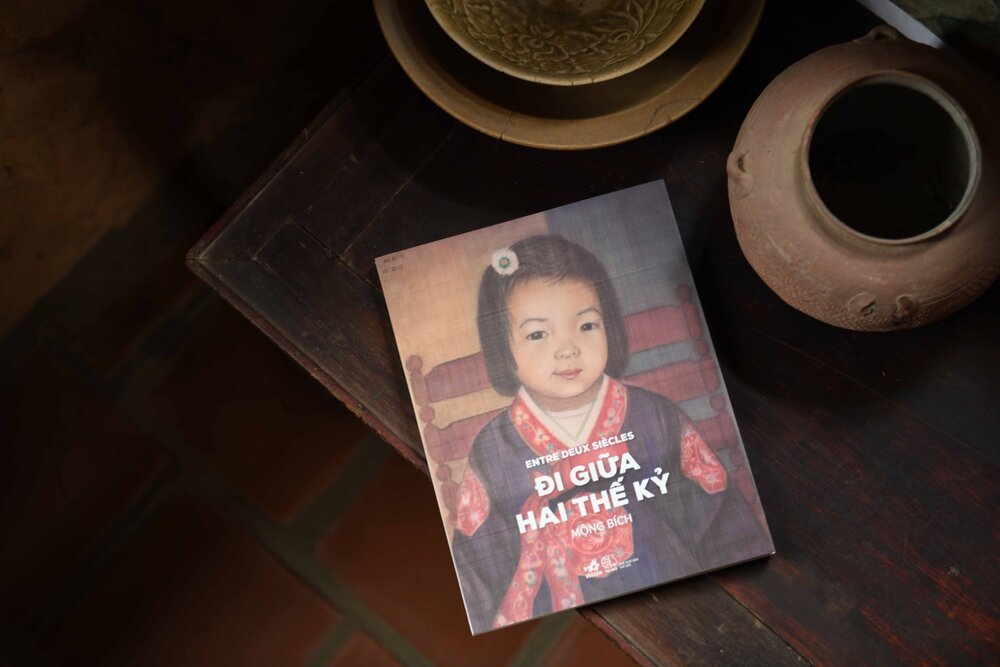Review of Mong Bich's 'Between Two Centuries'
Debut solo exhibition by overlooked female painter from Hanoi
By Duong Nguyen
Artist Mong Bich at her house in Bac Ninh, photo taken in 2020. Image courtesy of Bui Hoai Nam Son.
"Mong Bich has not only lived longer than most of her peers, but she is also an embodiment of changes in Vietnam and its art history in the last century." These were the words of Professor Nora A. Taylor in discussing the painter Mong Bich, who is now in her 90s. Organised by curators from L'Espace, Hanoi, in collaboration with the artist's family, her first solo exhibition 'Between Two Centuries' is a recognition of Mong Bich's unique position in Vietnam’s cultural heritage.
The show features 30 sketches and paintings that span the 1960s to the present. Stepping into the gallery, it feels as though I am witnessing history coming to life. Majority of the paintings on view are portraits made in the early 1990s. Unlike works by her contemporaries such as Nguyen Tien Chung, Le Thi Kim Ngoc and Nguyen Thanh Ngoc, Mong Bich worked with watercolour on silk rather than oil on canvas. "When you see her wonderful works, it is hard not to hold an exhibition like this," says Thierry Vergon, Director of L'Espace. It is an opportunity to introduce more than 60 years' worth of work by an underground artist, who came from a humble background and never sought to make her art art a lucrative career.
‘Between Two Centuries’, 2020, exhibition installation view at L'Espace, Hanoi. Image courtesy of L'Espace.
‘Between Two Centuries’, 2020, exhibition installation view at L'Espace, Hanoi. Image courtesy of L'Espace.
Vietnamese art reflects the country’s strife-ridden history in the twentieth century. Following its independence from France in 1954, Vietnam pursued an isolationist policy and closed its border. During this period, the country focused on agricultural development and allocated little resources to the arts. Fortunately, the Hanoi University of Fine Arts continued to educate young students on traditional art and Mong Bich studied learning under artists Tran Van Can, Bui Xuan Phai – both masters in their field, with works on display in the Vietnam National Fine Arts Museum.
Painting allowed Mong Bich to capture reality as she saw it. Tran Van Can, who was also formerly Director of Hanoi University of Fine Arts, comments that Mong Bich “paints with instinct and emotion". Her works are sincere depictions of people and nature, a vastly different image from the prevailing "socialist realist" movement which focused on projecting a strong, independent Vietnam. “No one wanted to buy my paintings at the time because they depicted only rural old women and ethnic minorities, which were not the trend,” Mong Bich shares. Going against the trend meant that she was an outsider and had little success in selling her works.
However, Mong Bich remained indifferent to changes in Vietnam’s art scene, even as the country began to open its borders in 1995. The influx of Western contemporary art introduced new experiences and ideas, and the character of Vietnamese art evolved when presented with new directions from the outside world. Artists became a brand, and they created brighter, more positive imagery through paintings and propaganda posters. Instead of chasing what was in fashion, Mong Bich's paintings act like a diary record of her own emotions and journeys, allowing her artworks to remain true to her vision.
Mong Bich, 'Bà già', 1993, watercolour on silk, 47.5 x 64cm. Image courtesy of L’Espace.
Being a mother and a Vietnamese woman allowed Mong Bich to empathise with her subjects, who tend towards women of an older age, working class or ethic minorities. Viewers can easily identify individual characters in her evocative portraits. This affective quality is recognised by some members of the local arts community. In 1997, Mong Bich won the first prize in the Vietnam Fine Arts Association's annual competition for her silk painting 'Bà Già' (1993).
Mong Bich outside her house in Bac Ninh, photo taken in 2020. Image courtesy of Bui Hoai Nam Son.
Mong Bich, 'Tĩnh vật', 2016, watercolour on Dó paper, 48 x 36cm. Image courtesy of L'Espace.
Today, Mong Bich lives in a small house on a hill in Hien Van village in Bac Ninh, just outside of Hanoi. It was built 10 years ago with the prize money from winning art competitions. The compound also houses her first studio, which coupled with a walking difficulty, are the reasons why Mong Bich stopped being the roaming painter. Settling down in a quiet space has also allowed her to focus on still life paintings, as she draws inspiration from everyday objects. In her recent silk paintings, fruits and vegetables such as bananas and potatoes are rendered in a vibrant realist style.
Catalogue published by Nha Nam in conjunction with the exhibition 'Between Two Centuries' (2020). Vietnamese-French bilingual book, 20 x 27cm, 100 pages. Image courtesy of Bui Hoai Nam Son.
'Between two centuries' encapsulates a part of Hanoi's history as well as the soul of a veteran artist. This attempt to broaden the historical narrative is supported with a book published in conjunction with the exhibition. Notably, it is the first catalogue of Mong Bich's work, offering rich discussions from the perspectives of fellow artists, scholars and cultural activists. Written in Vietnamese and French, the publication is valuable in helping local audiences understand more about the experiences, peoples and places behind each painting on view.
Despite her impressive age, Mong Bich is full of vitality and years of painting ahead of her. When asked by a friend why she does not rest, Mong Bich replies, "For me, drawing is resting. I will draw until I cannot draw anymore."
‘Entre Deux Siècles’ (Between Two Centuries) is on view from 22 October to 22 November 2020, at L'Espace - French institute in Hanoi.


















